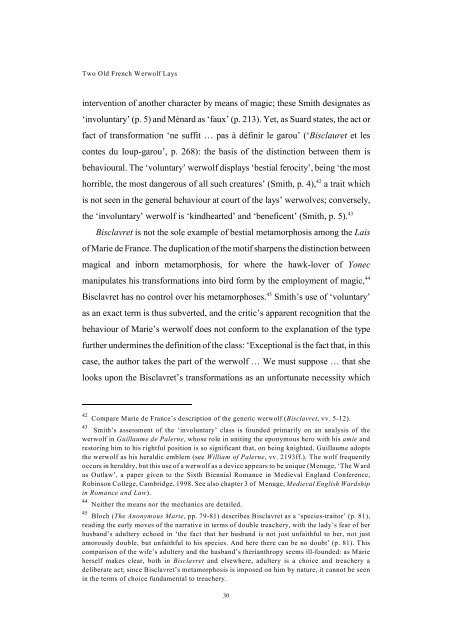Melion and Biclarel - University of Liverpool
Melion and Biclarel - University of Liverpool
Melion and Biclarel - University of Liverpool
Create successful ePaper yourself
Turn your PDF publications into a flip-book with our unique Google optimized e-Paper software.
Two Old French Werwolf Lays<br />
intervention <strong>of</strong> another character by means <strong>of</strong> magic; these Smith designates as<br />
‘involuntary’ (p. 5) <strong>and</strong> Ménard as ‘faux’ (p. 213). Yet, as Suard states, the act or<br />
fact <strong>of</strong> transformation ‘ne suffit … pas à définir le garou’ (‘Bisclauret et les<br />
contes du loup-garou’, p. 268): the basis <strong>of</strong> the distinction between them is<br />
behavioural. The ‘voluntary’ werwolf displays ‘bestial ferocity’, being ‘the most<br />
42<br />
horrible, the most dangerous <strong>of</strong> all such creatures’ (Smith, p. 4), a trait which<br />
is not seen in the general behaviour at court <strong>of</strong> the lays’ werwolves; conversely,<br />
the ‘involuntary’ werwolf is ‘kindhearted’ <strong>and</strong> ‘beneficent’ (Smith, p. 5). 43<br />
Bisclavret is not the sole example <strong>of</strong> bestial metamorphosis among the Lais<br />
<strong>of</strong> Marie de France. The duplication <strong>of</strong> the motif sharpens the distinction between<br />
magical <strong>and</strong> inborn metamorphosis, for where the hawk-lover <strong>of</strong> Yonec<br />
manipulates his transformations into bird form by the employment <strong>of</strong> magic, 44<br />
45<br />
Bisclavret has no control over his metamorphoses. Smith’s use <strong>of</strong> ‘voluntary’<br />
as an exact term is thus subverted, <strong>and</strong> the critic’s apparent recognition that the<br />
behaviour <strong>of</strong> Marie’s werwolf does not conform to the explanation <strong>of</strong> the type<br />
further undermines the definition <strong>of</strong> the class: ‘Exceptional is the fact that, in this<br />
case, the author takes the part <strong>of</strong> the werwolf … We must suppose … that she<br />
looks upon the Bisclavret’s transformations as an unfortunate necessity which<br />
42<br />
43<br />
Compare Marie de France’s description <strong>of</strong> the generic werwolf (Bisclavret, vv. 5-12).<br />
Smith’s assessment <strong>of</strong> the ‘involuntary’ class is founded primarily on an analysis <strong>of</strong> the<br />
werwolf in Guillaume de Palerne, whose role in uniting the eponymous hero with his amie <strong>and</strong><br />
restoring him to his rightful position is so significant that, on being knighted, Guillaume adopts<br />
the werwolf as his heraldic emblem (see William <strong>of</strong> Palerne, vv. 2193ff.). The wolf frequently<br />
occurs in heraldry, but this use <strong>of</strong> a werwolf as a device appears to be unique (Menuge, ‘The Ward<br />
as Outlaw’, a paper given to the Sixth Biennial Romance in Medieval Engl<strong>and</strong> Conference,<br />
Robinson College, Cambridge, 1998. See also chapter 3 <strong>of</strong> Menuge, Medieval English Wardship<br />
in Romance <strong>and</strong> Law).<br />
44<br />
45<br />
Neither the means nor the mechanics are detailed.<br />
Bloch (The Anonymous Marie, pp. 79-81) describes Bisclavret as a ‘species-traitor’ (p. 81),<br />
reading the early moves <strong>of</strong> the narrative in terms <strong>of</strong> double treachery, with the lady’s fear <strong>of</strong> her<br />
husb<strong>and</strong>’s adultery echoed in ‘the fact that her husb<strong>and</strong> is not just unfaithful to her, not just<br />
amorously double, but unfaithful to his species. And here there can be no doubt’ (p. 81). This<br />
comparison <strong>of</strong> the wife’s adultery <strong>and</strong> the husb<strong>and</strong>’s therianthropy seems ill-founded: as Marie<br />
herself makes clear, both in Bisclavret <strong>and</strong> elsewhere, adultery is a choice <strong>and</strong> treachery a<br />
deliberate act; since Bisclavret’s metamorphosis is imposed on him by nature, it cannot be seen<br />
in the terms <strong>of</strong> choice fundamental to treachery.<br />
30
















